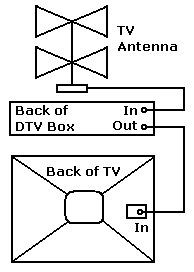DTV Technology Questions
|
QUESTION. Do I need to buy a "digital antenna"? ANSWER. No. There is no such thing as a "digital antenna." Over-the-air signals propagate as waves. Both digital and analog signals are waves. Also, both occupy the same frequencies. Since the factory cut your analog antenna to cover these TV frequencies, you're probably okay. Maybe your TV antenna has seen better years, and might be missing a few pieces. If so, check out your digital reception. If reception is poor, then maybe a new antenna would help. If pictures look okay, then the old antenna has a few more years on it. |

|
Some of us use rabbit ears right on the set. Do the rabbit ears bring in analog shows? Then rabbit ears will probably work for digital TV, too. But there's one exception. Your rabbit ears might be built into the TV. For the non-technical, connecting built-in rabbit ears to the converter could be troublesome. If so, then buying a new set of rabbit ears might be the easy way out. Again, plain, old rabbit ears will do the job. Don't let the "nice salesman" sell you anything deluxe and expensive.
QUESTION. I really need a new antenna. What type works best with a DTV box?
ANSWER. We've had good luck with multi-bay bow tie antennas. The pickup area on these antennas is fairly broad. If your stations aren't all in line, the bow tie is definitely the way to go. The indoor unit has two bow ties. This antenna is small and fits on or near the set. A typical outdoor unit might have two, four or eight bow ties. If you're in a weak signal area, go for the eight-bay bow tie.
The manufacturers cut these bow tie antennas for the UHF stations. In our area, near a large city, the bow ties do well with VHF signals, too. But if you're persnickety, you'll need a separate VHF antenna. Also, if you're in an area where stations are on different compass points, you'll need a rotator.
QUESTION. Is digital TV really better?
ANSWER. It's better than no television. That's the choice that our government is giving us.
Technical differences. There are many technical differences between analog and digital television. For some people, these differences might give one or the other technology an advantage. Here are a few examples...
- Signal strength. The average signal strength of the television picture is one example. For example, a DTV picture has a stronger average strength than an analog picture has. Yet, if you're near to a transmitter, the comparative signal strengths make little difference.
- Ghosts. Digital television is very good at canceling ghosts. For years, analog sets have included saw filters that also cancel ghosts. The digital software does the job a little better than the saw filters did.
- Cliff Effect. The Cliff Effect is a problem of digital television. When you're far from the transmitter ("in a fringe area"), analog TV pictures look "snowy." Digital pictures are free of snow, but dependable fringe reception might be impossible. In other words, digital television is all or nothing. This is what we mean by the Cliff Effect. In the normal coverage area, digital TV produces good pictures. Outside that area, unfortunately pictures are unlikely. The closest thing to fringe reception is a digital station that flips in and out. According to the WTFDA, a DX association, long-distance reception by ionospheric ducting might be possible. At best, such reception would be occasional.
- Artifacts. Digital artifacts plague digital TV. DTV uses a staggering amount of signal compression. The annoying artifacts are the cost of the that compression.
QUESTION. What about HDTV? Is that really better?
ANSWER. The answer depends on what you expect, and what you're trying to do with your television set. The wide screen picture seems to be a better shape for viewing with two eyes. At a normal viewing distance, the screen provides imagery for both eyes. For that reason, the elongated, rectangular picture shape gives HDTV a slight advantage.
The HDTV picture has a considerably higher resolution than standard-definition television has. Yet this extra resolution might not be useful. Viewing tests prove that this resolution is only visible when you're close to the screen. A typical, normal viewing distance is four to six times screen height. At that distance, most people can't see the difference between SDTV and HDTV! As an "advantage," then, high definition is mostly hype.
For decades, the television industry has known the basic facts on viewing distance and screen definition. RCA performed the research in the 1930s. This might seem like an old story. Why wouldn't newer research be helpful? Because human vision hasn't measurably improved since RCA's research. We can only conclude that the main reason for higher definition is to promote sales. Not surprisingly, an HDTV is a high-margin appliance.
|
QUESTION. Where do I install the converter? ANSWER. Connect the 75-ohm lead from the TV antenna to the converter box. Now you have two choices...
|

|
QUESTION. My TV set doesn't have a 75-ohm jack. Instead, my TV has two screw-like connectors for an antenna. How do I connect the converter?
ANSWER. Your TV is the type that accepts 300-ohm, balanced twinlead antenna wire. The converter box output connects to 75-ohm, unbalanced coaxial cable. The plug at the output side of this cable is an "F" connector. You need a cable adapter that we call a "balun" transformer (for balanced and unbalanced.) Follow these steps...
- Buy your balun transformer. Summit Source carries baluns. Get the type with an F connector at one end. The other end must have two, U-shaped lugs.
- Mount the 75-ohm lead (F connnector) from the converter box to the balun.
- Screw the balun lugs to the TV set's antenna connectors. Now, you're in business.
QUESTION. Does my VCR need a converter, too?
ANSWER. The answer depends on how you use your VCR. The same rules apply to DVD recorders and TiVo recorders...
You don't need a converter if you...
- Use your VCR just to watch programs.
- Use your VCR to record just one show, but don't watch other shows simultaneously.
You need a converter if you...
- Use your VCR to record programs, and need the VCR to change channels.
- Use your VCR to record one show, as you watch other shows simultaneously.
QUESTION. Can I watch DTV before the changeover?
ANSWER. Yes.
Go to Page: 1 2 3 4 5 6 7 8 9 Next